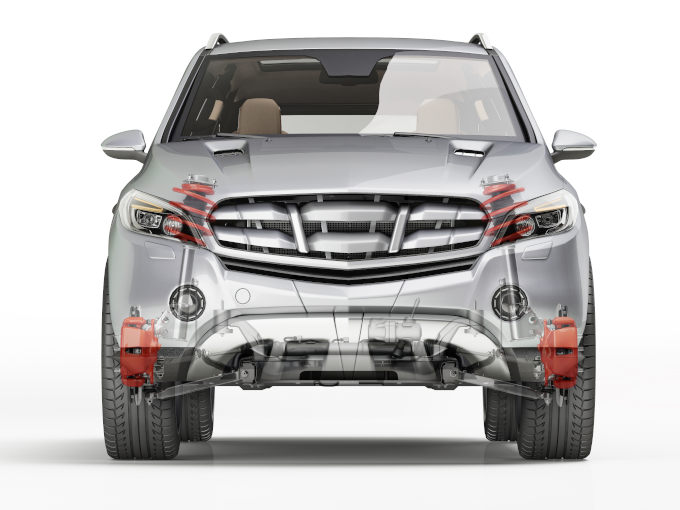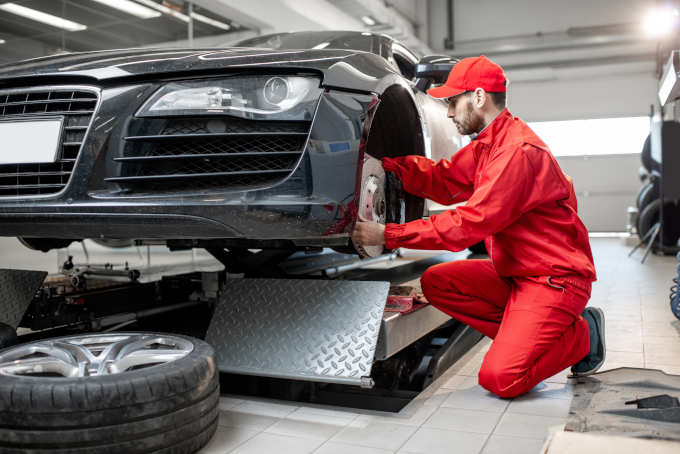For vehicle owners, nothing screams "Uh oh!" like the sudden appearance of suspension trouble.
When your vehicle's suspension isn't working properly, it can cause all sorts of problems—from an uncomfortable ride to uncontrolled bouncing and swaying. Knowing how to identify suspension problems can help you remedy them more quickly.
What Is a Suspension System?
Your suspension system is an important set of parts that the weight of your vehicle, maintain traction with the road, and provide steering stability during driving or turning. Suspension systems include shocks, struts, springs, anti-roll bars, sway bars, bushings, control arms, ball joints, tie rods/rack-and-pinion steering components, brake lines, brake pads, and several other components.
As you drive, your vehicle's shocks and struts support the weight of the vehicle. When you brake, springs compress to absorb the force of deceleration.
When you turn, anti-roll bars help keep your tires on the road by reducing body roll (the side-to-side movement of your car during turns).
Meanwhile, sway bars reduce the amount of sway (or "nose-diving" and "tail-raising") that can occur during hard cornering.
All these components work together to help keep your car stable and comfortable while you're driving. If any of these critical parts should fail, you'll likely experience one or more of the four main signs of suspension trouble.
4 Signs of Suspension Trouble
1. Your Vehicle Is Swaying or Wobbling
Have you ever noticed your car's body swaying or wobbling when you're driving at high speeds, turning corners, or braking? This may be a sign that your vehicle's shocks and struts are worn or faulty.
The Problem: Shocks and struts help control the movement of your car's body. When they're worn or damaged, they can't do their job properly, which causes the body to move more than it should.
What to Do: Have your shocks and struts checked by a mechanic as soon as possible. If they're worn or damaged, they'll need to be replaced.
2. Your Vehicle Is Bouncing More Than Usual
Do you feel like your car is bouncing more than usual when you drive over bumps, potholes, or other irregularities in the road? This could be a sign that your shocks and struts are worn out and need to be replaced.
The Problem: Worn shocks and struts can no longer absorb the normal amount of shock from your car's wheels hitting irregular surfaces, which causes the force to travel up to the body instead. When this happens, you feel a bounce similar to if you were riding in an elevator.
What to Do: Have your shocks and struts checked by a mechanic as soon as possible. If they're worn out, they'll need to be replaced.
3. Your Car is Bottoming Out
Have you ever driven over a big bump or pothole and felt your car's front or rear end hitting the ground hard? This is known as "bottoming out," and it's often a sign that your shocks or struts need to be replaced.
The Problem: When shocks and struts are worn out, they can no longer absorb the normal amount of shock from your car's wheels hitting irregularities in the road. This causes the force to travel up to the body, which can cause damage to your car and lead to a dangerous situation.
What to Do: Have your shocks and struts checked by a mechanic as soon as possible. If they're worn out, they'll need to be replaced.
4. Your Car is Rocking Back and Forth
Do you feel your car rocking back and forth when you drive over bumps or irregularities in the road? This could be a sign that your car's springs are worn out and need to be replaced.
The Problem: Springs help absorb the shock of your car hitting irregularities in the road. When they're worn out, they can't do their job correctly, which causes the car to rock back and forth more than it should.
What to Do: Have your shocks and struts checked by a mechanic as soon as possible. If they're worn out, they'll need to be replaced.
The Risks of Skipping Suspension Maintenance and Repair
If you're experiencing any of these four signs of suspension trouble, don't wait—have your car checked by a mechanic as soon as possible. Worn or damaged shocks, struts, springs, and other suspension parts can lead to several problems, including:
- Uncontrollable bouncing and swaying
- Damage to the car's body and frame
- Inefficient braking and premature brake wear
- Reduced fuel efficiencyPremature tire wear
So don't take any chances—if you think your car may be experiencing suspension trouble, have it checked out right away. Your mechanic will be able to identify the problem and suggest any necessary repairs.
If your car isn't experiencing any of these signs, you can breathe easy – for now. But that doesn't mean you should ignore the condition of your suspension system.
Even if your car seems fine, worn shocks or struts could be lurking just around the corner, ready to cause problems down the road. So it's a good idea to have your car's suspension system checked periodically, especially if you're experiencing any of the four signs of trouble listed above.
By catching any problems early, you can avoid expensive repairs and down the road.
Keep these tips in mind, and you'll enjoy a smooth ride for years to come!
Is Your Ride a Bit Bouncy? We’re Can Help
If your vehicle is showing signs of suspension issues, the best course of action is to have it checked out by a qualified technician before more serious issues arise. Ensure your safety on the road by contacting us today!










